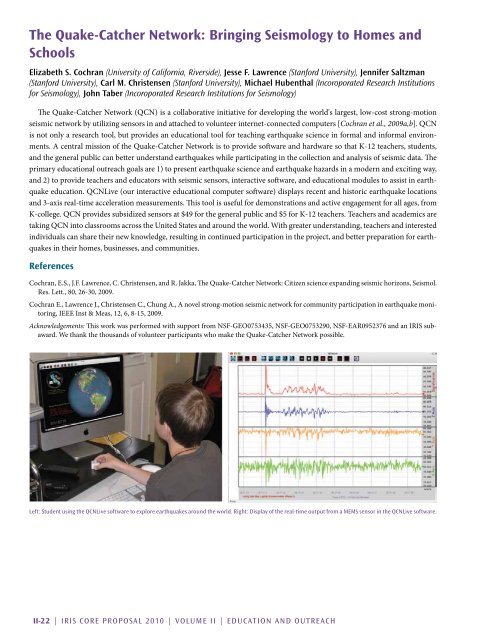Accomplishments - IRIS
Accomplishments - IRIS
Accomplishments - IRIS
You also want an ePaper? Increase the reach of your titles
YUMPU automatically turns print PDFs into web optimized ePapers that Google loves.
The Quake-Catcher Network: Bringing Seismology to Homes and<br />
Schools<br />
Elizabeth S. Cochran (University of California, Riverside), Jesse F. Lawrence (Stanford University), Jennifer Saltzman<br />
(Stanford University), Carl M. Christensen (Stanford University), Michael Hubenthal (Incoroporated Research Institutions<br />
for Seismology), John Taber (Incoroporated Research Institutions for Seismology)<br />
The Quake-Catcher Network (QCN) is a collaborative initiative for developing the world's largest, low-cost strong-motion<br />
seismic network by utilizing sensors in and attached to volunteer internet-connected computers [Cochran et al., 2009a,b]. QCN<br />
is not only a research tool, but provides an educational tool for teaching earthquake science in formal and informal environments.<br />
A central mission of the Quake-Catcher Network is to provide software and hardware so that K-12 teachers, students,<br />
and the general public can better understand earthquakes while participating in the collection and analysis of seismic data. The<br />
primary educational outreach goals are 1) to present earthquake science and earthquake hazards in a modern and exciting way,<br />
and 2) to provide teachers and educators with seismic sensors, interactive software, and educational modules to assist in earthquake<br />
education. QCNLive (our interactive educational computer software) displays recent and historic earthquake locations<br />
and 3-axis real-time acceleration measurements. This tool is useful for demonstrations and active engagement for all ages, from<br />
K-college. QCN provides subsidized sensors at $49 for the general public and $5 for K-12 teachers. Teachers and academics are<br />
taking QCN into classrooms across the United States and around the world. With greater understanding, teachers and interested<br />
individuals can share their new knowledge, resulting in continued participation in the project, and better preparation for earthquakes<br />
in their homes, businesses, and communities.<br />
References<br />
Cochran, E.S., J.F. Lawrence, C. Christensen, and R. Jakka, The Quake-Catcher Network: Citizen science expanding seismic horizons, Seismol.<br />
Res. Lett., 80, 26-30, 2009.<br />
Cochran E., Lawrence J., Christensen C., Chung A., A novel strong-motion seismic network for community participation in earthquake monitoring,<br />
IEEE Inst & Meas, 12, 6, 8-15, 2009.<br />
Acknowledgements: This work was performed with support from NSF-GEO0753435, NSF-GEO0753290, NSF-EAR0952376 and an <strong>IRIS</strong> subaward.<br />
We thank the thousands of volunteer participants who make the Quake-Catcher Network possible.<br />
Left: Student using the QCNLive software to explore earthquakes around the world. Right: Display of the real-time output from a MEMS sensor in the QCNLive software.<br />
II-22 | <strong>IRIS</strong> Core Proposal 2010 | Volume II | education and outreach

















